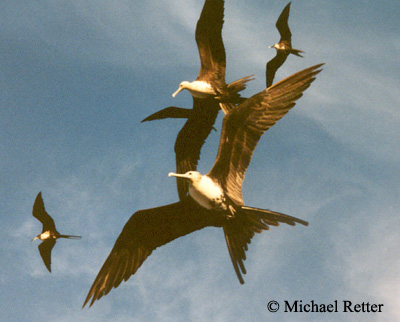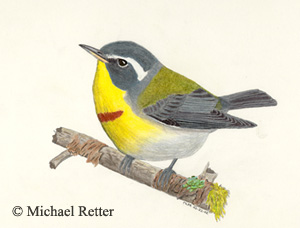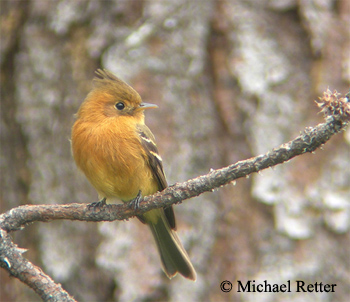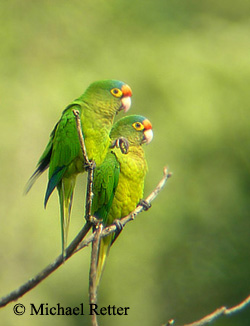
Red Warblers, Yellow Grosbeaks, and Blue-footed Boobies
Forthcoming Departures:
23 February-4 March 2007 (10 days)
$TBA per person from Mazatlán
Single Supplement: $TBA
22 February-3 March 2008 (10
days)
$TBA per person from Mazatlán
Single Supplement: $TBA
In addition to some of the most breathtaking
scenery Mexico has to offer, our San Blas-Northwest Mexico tour gives
you chances to see over forty Mexican endemics, eleven of which are
found in Northwest Mexico and nowhere else
 Day
1: Arrive in the coastal resort town of Mazatlán. You
we be greeted by your guide and the frigatebirds, and be taken to the
hotel for the
night.
Day
1: Arrive in the coastal resort town of Mazatlán. You
we be greeted by your guide and the frigatebirds, and be taken to the
hotel for the
night.
Day 2: La Noria
to Capilla de Taxte. This morning we will bird the arid
Northwestern thorn-forest. Endemics we'll target include Elegant
Quail, Black-throated Magpie-Jay, Purplish-backed Jay, Lilac-crowned
Parrot, Golden-cheeked Woodpecker, Black-vented Oriole, and
Rufous-bellied Chachalaca. With some luck, we may catch a Mexican
Beaded Lizard crossing the road. We'll spend the night in Capilla
de Taxte.
 Days 3-4: The
Durango Highway. We'll bird various sites along
this well-known highway the next two days. The most famous is
Barranca Ranch Liebre, a high-elevation pine-oak site that is the only
readily accessible location in the world to see the floppy-crested
Tufted Jay. The species list here is incredibly long:
White-striped Woodcreeper, Mountain Trogon, Red-headed Tanager,
"Gray-eared" Red Warbler, Crescent-chested Warbler, Rufous-crowned
Brush-finch, Golden-browed Warbler, and Tufted Flycatcher to name a
few. Stygian Owl, Eared Quetzal, and Thick-billed Parrot all
occur here but tend to be quite elusive. We must be sure to keep
an eye to the sky: White-naped Swift, the
world's largest with a nearly 2-foot wingspan, can often be seen
cruising just over the treetops. Time will also be spent along the
Panuco Road, which offers lower elevation foothill species like Golden
Vireo, Lesser Roadrunner, Golden-crowned Emerald, Russet-crowned
Motmot, Cinnamon Hummingbird, Colima Pygmy-Owl, Military Macaw, Blue
Mockingbird, Orange-fronted Parakeet, Grayish Saltator, and
Rusty-crowned Ground-Sparrow. Nights in Capilla de Taxte.
Days 3-4: The
Durango Highway. We'll bird various sites along
this well-known highway the next two days. The most famous is
Barranca Ranch Liebre, a high-elevation pine-oak site that is the only
readily accessible location in the world to see the floppy-crested
Tufted Jay. The species list here is incredibly long:
White-striped Woodcreeper, Mountain Trogon, Red-headed Tanager,
"Gray-eared" Red Warbler, Crescent-chested Warbler, Rufous-crowned
Brush-finch, Golden-browed Warbler, and Tufted Flycatcher to name a
few. Stygian Owl, Eared Quetzal, and Thick-billed Parrot all
occur here but tend to be quite elusive. We must be sure to keep
an eye to the sky: White-naped Swift, the
world's largest with a nearly 2-foot wingspan, can often be seen
cruising just over the treetops. Time will also be spent along the
Panuco Road, which offers lower elevation foothill species like Golden
Vireo, Lesser Roadrunner, Golden-crowned Emerald, Russet-crowned
Motmot, Cinnamon Hummingbird, Colima Pygmy-Owl, Military Macaw, Blue
Mockingbird, Orange-fronted Parakeet, Grayish Saltator, and
Rusty-crowned Ground-Sparrow. Nights in Capilla de Taxte.Day 5: To San Blas. We may do some early-morning cleanup birding along the highway, after which we'll head south to San Blas.
 Days
6 and 8: San Blas. Famous for decades as Mexico's
winter birding hotspot, this small, cozy coastal fishing village offers
plenty of birding within a short drive. Habitats are varied, and
so are the birds. Some of our targets include Mexican Parrotlet,
Cinnamon-rumped Seedeater, Blue Bunting, Godman's Euphonia, Citreoline
Trogon, Yellow-winged Cacique, Red-breasted Chat, Fan-tailed Warbler,
Bare-throated Tiger-Heron, and Rufous-backed Robin. We'll be sure
to take a river cruise up into the mangroves to look for Boat-billed
Heron, Crane Hawk, Rufous-necked Wood-Rail, Common Potoo, Mangrove
Vireo, Mangrove Warbler, and Mangrove Cuckoo. Shorebirding around
town is often productive and may get us looks at Collared Plover.
There's even offshore birding to do, and we may well see two species of
booby. These two days will be quite leisurely, and afternoon
outings are optional. Nights in San Blas.
Days
6 and 8: San Blas. Famous for decades as Mexico's
winter birding hotspot, this small, cozy coastal fishing village offers
plenty of birding within a short drive. Habitats are varied, and
so are the birds. Some of our targets include Mexican Parrotlet,
Cinnamon-rumped Seedeater, Blue Bunting, Godman's Euphonia, Citreoline
Trogon, Yellow-winged Cacique, Red-breasted Chat, Fan-tailed Warbler,
Bare-throated Tiger-Heron, and Rufous-backed Robin. We'll be sure
to take a river cruise up into the mangroves to look for Boat-billed
Heron, Crane Hawk, Rufous-necked Wood-Rail, Common Potoo, Mangrove
Vireo, Mangrove Warbler, and Mangrove Cuckoo. Shorebirding around
town is often productive and may get us looks at Collared Plover.
There's even offshore birding to do, and we may well see two species of
booby. These two days will be quite leisurely, and afternoon
outings are optional. Nights in San Blas.  Day
7: La Bajada. Not far from San Blas is a nicely-wooded
coffee finca offering many new species for our trip, as well as nice
flocks of wintering migrants. Some of the more popular migrants
seen here include Varied Bunting, Black-capped Vireo, and Flame-colored
Tanager. As for resident birds, Crested Guan, Slate-throated
Whitestart, Brown-backed Solitaire, and San Blas Jay are all
possibilities. The hummingbirds here are a real treat.
Mexican Hermit, Mexican Woodnymph, and Sparkling-tailed Woodstar occur
here, and the first two are range-restricted Mexican endemics.
Though elusive, we'll certainly try to see a Rosy Thrush-Tanager.
Night in San Blas.
Day
7: La Bajada. Not far from San Blas is a nicely-wooded
coffee finca offering many new species for our trip, as well as nice
flocks of wintering migrants. Some of the more popular migrants
seen here include Varied Bunting, Black-capped Vireo, and Flame-colored
Tanager. As for resident birds, Crested Guan, Slate-throated
Whitestart, Brown-backed Solitaire, and San Blas Jay are all
possibilities. The hummingbirds here are a real treat.
Mexican Hermit, Mexican Woodnymph, and Sparkling-tailed Woodstar occur
here, and the first two are range-restricted Mexican endemics.
Though elusive, we'll certainly try to see a Rosy Thrush-Tanager.
Night in San Blas.Day 9: Back to Mazatlán. Before we head back north, we may try to do some cleanup birding around San Blas.
Day 10: Departure. Today you will depart the airport for home.
CLIMATE: Varied. Though it seldom gets too hot, cold, or wet this time of year, it's best to be prepared. It could be chilly at upper elevations in the morning, and warm at lower elevations midday.
DIFFICULTY: Moderately
easy. Most of our time will be spent
walking on roads, but there is a small, pleasant hike up a trail at
Barranca Rancho Liebre.
For more
information, contact Michael Retter at mlretter AT yahoo.com